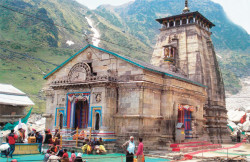|
||||||||||||||||||||||||||||||||||||||||||||||
 |
||||||||||||||||||||||||||||||||||||||||||||||
|
21 May Delhi – Haridwar (230 kms/6-7hrs) HT : 314 MTS. Arrival Delhi Railway Station, Pickup by ( Ac. Will work on This Day and Last Day only ). Meet & Assist further drive to Haridwar. Transfer to your Hotel. If time permits visit Mansadevi Temple, Chandidevi Temple, Daksha Mahadev Temples & Others. Also visit Har-ki-Pauri for Ganga Aarti. The ‘Aarti’ worship of the Ganga after sunset and the floating ‘dia’ (lamp) is a moving ritual. Chandi Devi Temple Back to your hotel, Night halt. |
||||||||||||||||||||||||||||||||||||||||||||||
|
22 May Haridwar – Barkot (210kms/7-8hr) HT : 1352 MTS. Weather – Generally pleasant in summer, the temperature ranges from 25-30 degree Celsius, Winter: The Days are pleasantly cool but the nights are cold,temp ranges from 10 deg to 05 deg. |
||||||||||||||||||||||||||||||||||||||||||||||
|
23 May Barkot – Yamunotri – Barkot {36kms drive & 6kms Trek (one side)} HT : 3235 MTS. Yamunotri Temple: Maharani Gularia of Jaipur built the temple in the 19th Century. It was destroyed twice in the present century and rebuilt again. Surya Kund: There are a Number of thermal springs in the vicinity of the temple, which flows into numerous pools. The most important of these is Surya Kund. Divya Shila: A rock pillar, worshipped before entering the Yamunotri Temple. |
||||||||||||||||||||||||||||||||||||||||||||||
|
24 May Barkot – Uttarkashi (100kms/4hr) HT :1352 MTS. Uttarkashi is home to a number of ashrams and temples and also to the Nehru Institute of Mountaineering. The name of the town reflects its similarity to and location (as north of) the city of Kashi (Varanasi). Similar to Varanasi, town of Uttarkashi is situated on the Ganges, lies next to a hill named Varun Parvat, on confluence of two rivers Varuna and Asi, has a ghat called Manikarnika Ghat and has a temple dedicated to Shiva (Kashi Vishwanath Temple) in the center of the town. Vishwanath temple – Vishwanath temple is one of the oldest Shiva temples in Northern India. Re-constructed in 1857 by Maharani Khaneti Devi of Tehri State in the ancient architectural style. It is situated at the heart of the town. A massive iron trident, symbolic of divine mother’s, is erected and worshiped from time immemorial at the temple complex. Ganeshji, Sakshi Gopal, Markandeya Rishi’s small shrines are also part of the temple complex. Akhand Jyoti as well as Akhand Abhishek, special aarti at morning and evening are offered. As per Skunda Puran, Uttarkashi is known as ‘Saumya Varanasi’, the abode of Lord Shiva in Kaliyug and counted as one of the twelve Jyotirlingas. Shakti temple – Right in front of the Vishwanath temple is Shakti temple. It has a big ‘Trishul’ of about 6 meters in height and a circumference of 90 cms. at bottom. Though there are different views about the making of this, the upper part of it seems to be made up of iron and the lower one is of copper. As per the epics this Shakti was thrown on the devils by the Goddess Durga(Shakti), hence it gets its name. Since then this Shakti is erected over here |
||||||||||||||||||||||||||||||||||||||||||||||
|
25 May Uttarkashi – Gangotri – Uttarkashi (100kms/3-4 each side) HT : 3048 MTS. Kedar Ganga Sangam: Around 100 Yards from the Ganga Temple flows the river Kedar Ganga. Starting from the Kedar Valle, this river meets the Bhagirathi on its left bank. |
||||||||||||||||||||||||||||||||||||||||||||||
|
26 May Uttarkashi – Guptkashi (220kms/8-9hr) HT : 1319 MTS. Weather – Generally pleasant in summer, the temperature ranges from 25-30 degree Celsius. Cold in winters. |
||||||||||||||||||||||||||||||||||||||||||||||
|
27 May Guptkashi – Kedarnath (30kms by road & 19kms Trek) |
||||||||||||||||||||||||||||||||||||||||||||||
| 28 May Kedarnath – Guptkashi (19Kms Down Trek & 30kms/1hr by Road) Early morning you get up before dawn and after taking bath you are at the temple by 4:45 am for the ‘Abhishek’ to Kedarnath Shiva. Everyone can go inside Garbha Griha and touch the idol. You can also prostrate with your head touching the deity etc. After Temple Darshan trek down to Gaurikund, return back to Sonprayag (By Local Jeep – at own). Further drive to Guptkashi. Check in Hotel. Night Halt. |
||||||||||||||||||||||||||||||||||||||||||||||
| 29 May Guptkashi – Badrinath (215kms/7hr) HT : 3133 MTS. Drive to Badrinath via Joshimath. Check in Hotel. Later at evening visit Badrinath Temple for Aarti. Overnight stay.Badrinath one of the ‘Four Dhams’ is one of the most celebrated pilgrimage spots of the country and is situated at an elevation of 3,133 meters, guarded on either side by the two mountain ranges known as Nar & Narayan with the towering Neelkanth Peak providing a splendid backdrop. This revered spot was once carpeted with wild berries. Thus the place got the name “Badri van”, meaning “forest of berries”. Tapt Kund : Natural thermal springs on the bank of the river Alaknanda, where it is customary to bathe before entering the Badrinath temple. Narad Kund : A recess in the river, near Tapt Kund, forming a pool from where the Badrinath idol was recovered. Brahama Kapal : A flat platform on the bank of river Alaknanda. Hindus perform proppitiating rites for their deceased ancestors. Sheshnetra : 1.5kms. away is a boulder having an impression of the legendary serpent, better known as the Sheshnag’s eye. Charanpaduka : 3kms. away is a beautiful meadow where the footprint of Lord Vishnu is seen on a boulder. Mata Murty Temple : Devoted to the mother of Sri Badrinathji. Other important temples include Sesh Netra Temple, Urvashi Temple and Charanpaduka. Mana Village : Inhabited by an Indo-Mongolian tribe, it is the last Indian village before Tibet. Vasundhara : As the name suggests, vasundhara is a magnificent water fall. This place is 5 kms. from Badrinath out of which 2 kms. is motorable upto Mana. Bhim Pul : On the other side of Mana village, a massive rock forming a natural bridge, lies over the roaring Saraswati river. It presents a spectacular view of water thundering down through the narrow passage under the rock and is believed to have been placed there by Bhim, the second eldest among the five Pandava brothers. Vyas Gufa (cave) : Near Mana Village, this is a rock-cave where Ved Vyas is believed to have composed the Mahabharata and the pauranic commentaries. |
||||||||||||||||||||||||||||||||||||||||||||||
| 30 May Badrinath – Rudraprayag (160kms) / Kirtinagar (200kms) Early morning, pilgrims after having a bath in the Taptkund have the Darshan of Badrivishal. Brahamakapal is significant for Pinddan Shraddh of ancestors (Pitrus). There are other interesting sightseeing spot like Mana, Vyas Gufa, Maatamoorti, Charanpaduka, Bhimkund and the “Mukh” of the Saraswati River. Just within the three kms of Badrinathjee. Later drive back to Rudraprayag / Kirtinagar via Joshimath. Check in Hotel. Overnight stay. Joshimath is situated on the slopes above the confluence of the rivers Alaknanda and Dhauliganga. Of the four ‘Maths’ established by Adi Shankaracharya, Joshimath is the winter seat of Badrinath. The idol is brought down to Joshimath and installed in the temple for people to worship. There are many other temples in the township. The most important is the temple of Nir Singh with the idol of Lord Vishnu. The left arm of this deity is getting destroyed with time and the popular belief holds that the day the arm completely withers Badrinath valley will cease to exist and the Gods will transfer the residence into the neighboring Niti Valley at Bhavishya Badri. |
||||||||||||||||||||||||||||||||||||||||||||||
|
31 May Rudraprayag – Rishikesh (140kms/4-5hr) / Kirtinagar – Rishikesh (110kms/3-4hr) Drive to Rishikesh, the ‘place of sages’ is a celebrated spiritual town on the bank of Ganga and is surrounded by Shivalik range of the Himalayas on three sides. It is said that when Raibhya Rishi did hard penances, God appeared by the name of ” Hrishikesh ” and this area hence firth came to be known as Rishikesh. Check in Hotel. Later visit Rishikesh Temples & Sight Seeing – Laxman Jhulla, Ram Jhulla, Triveni Ghat, Bharat Mandir, Shivananda Ashram. At evening visit Ganga Aarti at Parmarth Ashram. Overnight stay. Bharat Mandir: The Bharat Mandir is the oldest temple of Rishikesh, situated near the Jhanda Chowk. Rishi Rabhya did his penance at this holy spot and the place is devoted to Lord Vishnu. A spectacular sacred Shree Yanthra is placed at the inner canopy of the temple. Bharat Mandir celebrates colourful spring festival called ‘Basant Panchami’. Laxman Jhula: Lakshman Jhula is on of the main attraction of Rishikesh. It is 450 ft long hanging bridge on the river Ganga which was built in 1939. According to myths and legends Laksman, brother of Lord Rama crossed Ganga River on a jute rope from this point. The 13 storied temple is located near Lakshman Jhula where the idols of several Gods and Goddesses are kept. The bridge gives a magnificent view of the Ganges, greeting you with the cool breeze from the river. Ram Jhula: Ram Jhoola connects Swargashram with Shivananda Ashram. Several ashrams are located near Ram Jhoola. Ram Jhoola is bigger than Laxman Jhula and even more picturesque. |
||||||||||||||||||||||||||||||||||||||||||||||
| 01 June Rishikesh- Delhi (256 km, 7 hours’ drive) After Breakfast , depart to Delhi approx 256 kms / 07 hrs. Drop at railway station. |
||||||||||||||||||||||||||||||||||||||||||||||
|
Package Rates are per Couple in INR and details as below
|
||||||||||||||||||||||||||||||||||||||||||||||
|
Inclusions
|
||||||||||||||||||||||||||||||||||||||||||||||
Excludes
|
||||||||||||||||||||||||||||||||||||||||||||||
Please Note :-
|
||||||||||||||||||||||||||||||||||||||||||||||
Presently Available Air Fare: INR 13,000*4 – 52,000
|
||||||||||||||||||||||||||||||||||||||||||||||
23853 – Mr. Gehlot Ji // Chardham
Home / 23853 – Mr. Gehlot Ji // Chardham
Developed By
|Feelindia

